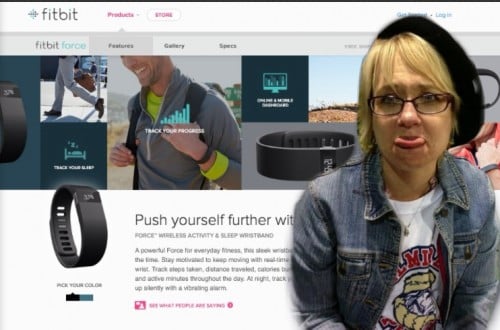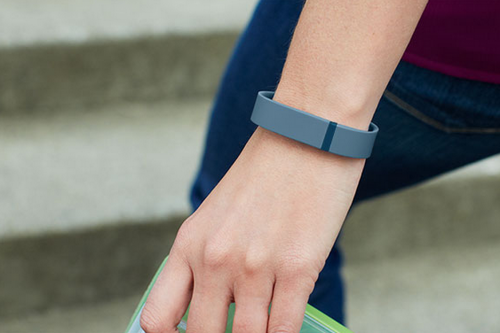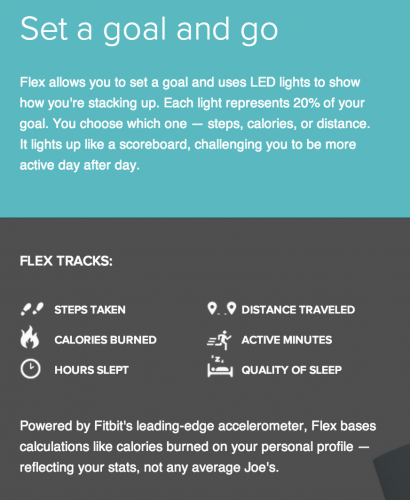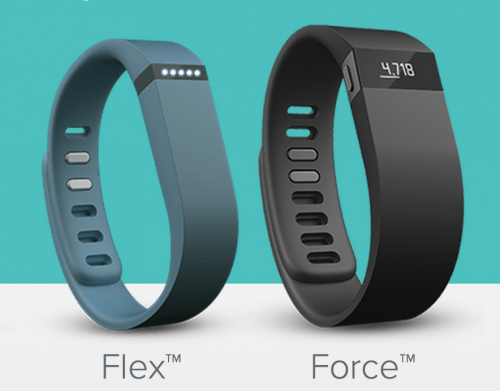I like Fitbit clip-on trackers because they measure sleep, steps, floors climbed, and they integrate well with Android and iOS fitness apps. But after losing two to the washing machine, I’d given up and moved to more convenient bracelet-style trackers. As an early adopter of Fitbit’s Flex bracelet-style tracker, I feel cheated by today’s release of the Force. Here’s why.
When Fitbit released the Flex, I had already been using the Jawbone UP for some time. Even so, I was willing to purchase Fitbit’s new bracelet-style tracker because I had previously had such good experiences with their products.
Finally, there was a water-resistant Fitbit that I could wear on my wrist!
Some background: I had been as faithful as possible about wearing my previous Fitbits, but there were times when I would forget to clip them on my clothing, and so there were days that I didn’t have tracking. But even worse — because the Fitbit did clip to clothing, there was always a chance that it might be knocked off a pocket when walking, or that it would stay on the clothing and go through the washer (as happened to me … twice).
$99 isn’t a crazy amount of money, but when you have to replace a $99 item more than once, it gets old fast.
So I bought the Fitbit Flex, and I wasn’t thrilled with my purchase. There were many reasons why — starting with the way the band attached to my wrist, but more than that, it was how I had to attach a dongle to my computer in order to sync the Flex, and I had to use another dongle to charge it; never mind that removing the counter module from the bracelet for charging was a pain.
Gone was immediate feedback about the exact number of steps I had taken that I had enjoyed on previous Fitbits; all numbers had been replaced with flashing LEDs. Gone was the ability to track floors climbed or elevation walked and run. In short, I wasn’t thrilled with my purchase.
What I wanted was a bracelet-style tracker that could measure my sleep, like the Flex and the Up; one that would measure my steps, like the Flex, Up, and Nike Fuelband (which I also owned). I wanted a bracelet-stye tracker that worked with iOS and Android, like the Flex and Up, but one that also displayed my steps, goals met, and the time in real numbers — like the Fuelband.
I ordered the Fitbit Flex May 6th, the first day they were available, and I received it later that month. I wore it for two weeks … and then I put it in a drawer and never thought about it again. Because of my experiences with the Up and Fuelband, I found the Flex inconvenient to use; I probably should have just returned it and asked for my money back, but I didn’t.
The Flex seemed like a “me, too” product, trying to capitalize on the bracelet-style fitness tracker market, but it stopped short on so many levels.
Which brings us to today.
This morning I received an email about the new Fitbit Force. This bracelet-style tracker addresses one of the biggest problems I had with the Flex by removing the LED dot system and putting in real numbers. Fitbit also borrowed a page from Nike and added a watch function, and even better — they put the elevation tracker back in, so that hills and staircase steps again counted for something.
Granted, the obnoxious dongle system is still there, but building a USB plug into the bracelet clasp would have likely resulted in Fitbit being sued by Nike. I guess that they had to draw the line somewhere.
So would I buy a Fitbit Force? I might have, if I hadn’t already bought the Force just five months ago. At $129.95, the Force it is not much more than the Fitbit Flex, but it offers much more functionality. At $129.95, the Force is still less than the Nike Fuelband, and it is the same price as the Jawbone UP.
Would I have purchased a Fitbit Flex had I known they would come out with a much better model in 5 months? Of course not. And therein lies the rub of being an early adopter.






Hmm… what you ended up writing seems to be less hostile than what the title suggests. I guess there’s a couple things I’m wondering about:
1) How long would Fitbit have had to take to release the Force for you to not feel screwed over by them?
2) If Fitbit gave you a $50 credit to trade, would you take it? Even if you didn’t, would you be somewhat mollified?
It reminds me about two things Apple has done. First, the $200 price drop for the original iPhone. They ended up offering $100 in store credit. Second, the 4th generation iPad, which came out just seven months after the 3rd generation iPad. I waited for the price drop, so that wasn’t an issue for me; the earlier-than-expected obsolescence of my retina iPad, on the other hand…
Well, I do *try* to be reasonable, but the title is actually taken from the sentence I sent to the editors when I received the email about the Force this morning. What I said was, and I quote, “well, that’s a big FU to anyone who ordered the sh*tty Fitbit Flex!” So really, I toned the title down. 😉
Q) How long would Fitbit have had to take to release the Force for you to not feel screwed over by them?
A) 9 months would have been nice, a year would have been ideal, because by then they might have figured out a way to get rid of the crappy dongle, or at least one of them, and I might have bought one.
Q) If Fitbit gave you a $50 credit to trade, would you take it?
A) No.
Q) Even if you didn’t, would you be somewhat mollified?
A) Absolutely. And this would have been a very different post.
More than most, I get that companies have to continuously upgrade and improve their products, and I expect to see that happen. But generally they give you a grace period where you can enjoy your product before they introduce the MOAR version that does what their original product should have done in the first place.
Thanks for the Apple reminder. I went through both, and I remember being quite pleased with the way the iPhone issue was handled. I also had an earlier-than-expected obsolete retina iPad. I still use it, and it is a GREAT device, so that didn’t bother me as much. But I think the difference here is that the device being replaced so quickly was an awesome device, so I didn’t feel ripped off because I didn’t wait. Make sense? That was *not* the case here.
Thanks for the discussion! =)